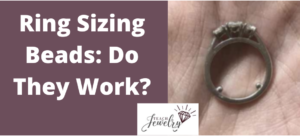
If your ring is too big for your finger, the first solution you might consider is resizing it.
A jeweler will cut a piece of the band, and reform it into a complete circle.
While this is an effective way to keep a ring from spinning, it won’t work for many types of settings, such as ones that include small diamonds on the shank.
Another popular choice is ring sizing beads.
We’ll explore everything you need to know about ring sizing beads, including how they’re added to the ring, if they work, costs, and alternatives.
What are Ring Sizing Beads?
Ring sizing beads involve two small metal spheres that are soldered inside the shank to reduce the amount of room between your finger and the band. They’re often created with sterling silver.
In the image below, notice there are two sizing beads placed toward the bottom of the shank.
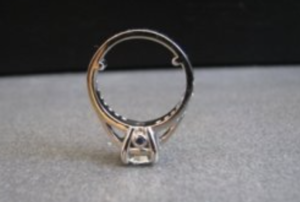
To begin the process, the jeweler cleans the ring.
They’ll place a mark in two places to identify where the beads will sit. Two strips of solder are placed under intense heat to attach them to the ring.
They’ll form a small indentation in the ring using a drill bit. This is where the solder is positioned after they’re heated and molded into small spheres.
The ring sizing bead is then placed on top of the spheres. Here’s what they look like before they’re added.
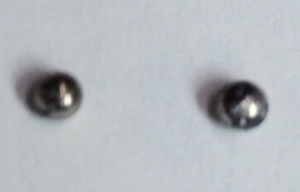
To present a sleek finish, the beads are polished and often plated with a new coat.
In most cases, beads reduce the size of the ring by one quarter to one half, but some are large enough to alter it by two sizes.
If you attempt to reduce the size by more than three, it results in a large gap between your finger and the ring.
Large ring sizing beads can also be uncomfortable to wear, so they’re often used for minor adjustments.
Do They Work?
Ring sizing beads are an effective way to reduce the size of a ring.
Notice in the example below the size of the beads.
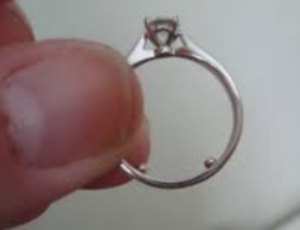
They’re big enough to close the gap between the shank and your finger but generally don’t create discomfort.
And don’t worry about them being noticeable when you’re wearing the ring. They’re covered by the metal and your finger.
They’re often used by those who have arthritis or swollen knuckles. The condition causes the ring to slide over your knuckles but still have a loose fit at the base of your finger.
For example, if your ring size is five but you have large knuckles, you might have to buy a size 5.5 to slide it over them. But when it’s over your knuckles, it’s loose.
The beads allow it to slide over them but then keep the ring from spinning because they reduced it by one half of a size.
They’re also helpful if your fingers get swollen when they’re cold and it’s unable to slide all the way down your finger.
If you decide ring sizing beads aren’t the right solution for you, they can be removed. Try placing them on your ring temporarily to learn which size is most comfortable.
It should be noted they generally don’t work on metals such as tungsten, titanium, or ceramic carbide because the beads don’t stick. The soldering process isn’t effective in melding the beads to the shank.
Fortunately, it’s rare to place pavé or channel diamonds on those types of metals, so they’re often fit for the traditional resizing process.
How Much Do Ring Sizing Beads Cost?
You can expect to pay between $35-$200 for ring sizing beads. The cost depends on the size of the beads, the type of metal used to create them, and any additional services like polishing or replating.
It requires a professional jeweler. There are many ways it can go wrong because it involves applying intense heat to the ring. The beads must be the right size to allow it to slide down your finger but no longer spin.
Most jewelers can add the sizing beads within a couple days, so the turnaround time is quick.
Alternatives
Ring Guards
Ring guards, also referred to as ring noodles, are small tubes of plastic placed over the ring. It’s a cheaper option than resizing your ring or having beads soldered onto the shank.
Check out the ring guards below.
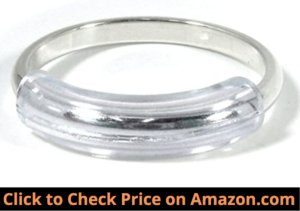
It’s easy to see how they function in a similar way as ring sizing beads. They’re isolated to the bottom half of the ring and help close the gap between the metal and your finger.
You won’t notice them unless you’re viewing the ring up close, because most ring guards have a transparent color.
One advantage is they come in multiple sizes. Whether your ring is one-half or three sizes too big, you can find a ring guard that’s right for you.
They’re easily removable and won’t cause any damage to the diamond or ring as you slide it on and off.
It’s a helpful solution as you learn whether you want to resize it using the traditional cutting process or settle on an alternative.
Spring Insert
Spring inserts are placed inside the shank. When you put on the ring, it tightens to hold it in place, but when you take it off, it loosens to allow the band to slide over your finger.
To illustrate, here’s an example of a ring with a spring insert.
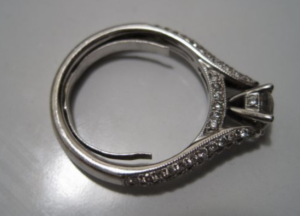
It’s shaped like a horseshoe and covers most of the bottom part of the ring.
While the exact size of the spring insert will determine how much it shrinks the ring, you’ll often see them used to reduce the ring by one half of a size.
Spring inserts are generally more comfortable than sizing beads, but they take up more room on the shank. But similar to ring sizing beads, no one will notice the insert when you’re wearing the ring.
It’s pressed tightly enough against your finger that it’s no longer apparent.
There are permanent and temporary options. I recommend starting with a temporary spring to learn if it’s the right solution for you.
Sizing Bar
Another alternative to ring sizing beads is a sizing bar. It’s a fold-over device that uses a U-shaped bar on the bottom of the shank. On one side, there’s a hinge, and on the other, there’s a latch.
I created a diagram of this solution and posted it below.
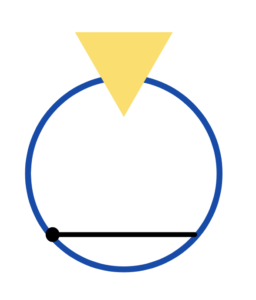
To put on the ring, open the latch, place it on your finger, and close it.
This method is most often used when a ring needs to be reduced several sizes.
This gives it an advantage over ring sizing beads, in addition to most people finding they don’t notice the device when wearing it.
Should You Add Sizing Beads to Your Ring?
Ring sizing beads are one of the many ways to tighten a ring with a loose fit.
They’re most often considered when there are constraints that prevent the jeweler from resizing the ring through cutting away part of the metal and soldering it back together.
If you’re considering whether they’re right for you, here are some questions to ask:
- Does your ring need a slight adjustment in size, or is it several sizes too big?
- Are there diamonds on the shank that would make resizing it difficult?
- Is your ring made of the type of metal where beads can be added?
- Are you interested in a solution that’s more permanent than alternatives like ring guards or spring inserts?
Fortunately, the beads can be removed if you learn they aren’t the right fit for you, so it’s a reversible decision.
While the most effective solution is resizing your ring, if this isn’t possible for any number of reasons, ring sizing beads are worth it.

Jacob Clarke
Jacob Clarke is the founder of TeachJewelry.com.
He earned an Applied Jewelry Professional Diploma from the Gemological Institute of America (GIA) and now brings you essential information about diamonds, settings, and more.
Jacob has consulted with leading jewelry brands, and his work has been cited in Clean Origin, Diamond Nexus and industry publications.
He's also a member of the International Gem Society.
He enjoys discussing jewelry with readers, so contact him with any questions at jacob.clarke@teachjewelry.com.













